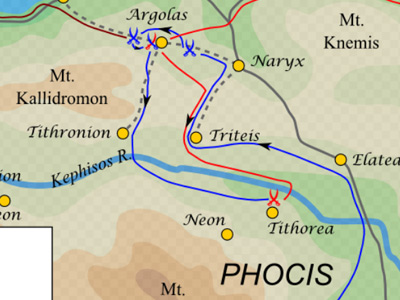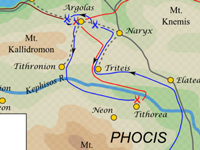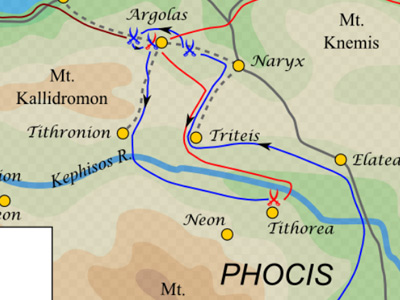Third Sacred War (356–346 BC)

Start of the War (c. 355 BC)
Following the declaration of war against Phocis, Philomelos decided he would need to substantially increase the size of his army. Rather than levy the Phocian citizen body, Philomelos decided to hire more mercenaries; the only way he could afford to do this was by plundering the dedications in the treasury of Apollo. That the treasury contained much wealth, from years of accumulated donations, is well-established; it is estimated that the Phocians spent some 10,000 talents of Apollo's treasure during the war. In order to overcome the reluctance of mercenaries to fight for a sacrilegious cause, Philomelos increased the rate of pay by half, which allowed him to recruit a force of 10,000 troops over the winter, for the forthcoming war.
Conflict in Epicnemidian Locris and Phocis (c. 355 BC)
The following spring, possibly upon hearing news that the Boeotians were ready to march against Phocis, Philomelos took the initiative and marched into Epicnemidian Locris. Since the Phocian army would be outnumbered by the whole Amphictyonic levy, it is probable that he sought to defeat his enemies one by one, starting with the Locrians. If he could defeat the Locrians, then he was in a position to occupy the narrow pass of Thermopylae and block the union of the Thessalian and Boeotian armies, the main Amphictyonic contingents. Philomelos's army thus crossed into Locris, probably using the Fontana pass from Triteis to Naryx, or possibly the Kleisoura pass from Tithronion to the same general area of Locris. The Locrians sent a force of cavalry to oppose him, which the Phocians easily defeated. However, this battle gave the Thessalians time to pass through Thermopylae and arrive in Locris. Philomelos immediately attacked the Thessalians, and defeated them near the town of Argolas, whose location is not definitively known. Buckler suggests, on the basis of topographical considerations, that the modern village of Mendenitsa must be ancient Argolas.
Philomelos then laid siege to Argolas, but failed to capture it, and instead pillaged as much Locrian territory as possible. The Boeotian army, under the command of Pammenes, then arrived on the scene, and rather than oppose them, Philomelos backed off, allowing the Boeotians to link up with the Locrians and Thessalians. Philomelos had thus failed in his strategy of dealing with the Amphictyons separately, and he now faced an army at least equal in size to his own. He therefore decided to retreat before the Amphictyons could bring him to battle, and probably using the Kleisoura pass, he returned with his army to Phocis.
Battle of Neon
In response to Philomelos's retreat, Pammenes ordered the Amphictyonic force to cross into Phocis as well, probably by the Fontana pass, in order to prevent Philomelos marching on Boeotia. The two armies converged on Tithorea (whose acropolis, Neon, gives the battle its name), where the Amphictyons brought the Phocians to battle. Details of the battle are scant, but the Amphictyons defeated the Phocians, and then pursued the survivors up the slopes of Mount Parnassos, slaying many. Philomelos was injured, and rather than risk capture, threw himself off the mountain, falling to his death. Onomarchos, who was second in command, managed to salvage the remainder of the army, and retreated to Delphi, whilst Pammenes retired to Thebes with the Boeotian army.
HISTORY

RESOURCES
This article uses material from the Wikipedia article "Third Sacred War (356–346 BC)", which is released under the Creative Commons Attribution-Share-Alike License 3.0.
© Stories Preschool. All Rights Reserved.









